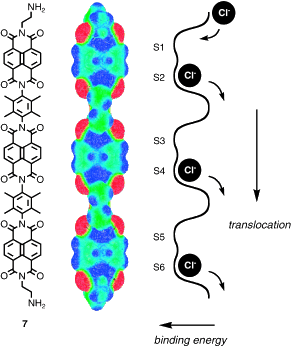- Mareda, J.; Matile, S. “Anion-π Slides for Transmembrane Transport” Chem. Eur. J. 2009, 15, 28-37

The recognition and transport of anions is usually accomplished by hydrogen bonding, ion pairing, metal coordination, and anion-dipole interactions. Here, we elaborate on the concept to use anion-π interactions for this purpose. Different to the popular cation-π interactions, applications of the complementary π-acidic surfaces do not exist. This is understandable because the inversion of the aromatic quadrupole moment to produce π-acidity is a rare phenomenon. Here, we suggest that π-acidic aromatics can be linked together to produce an unbendable scaffold with multiple binding sites for anions to move along across a lipid bilayer membrane. The alignment of multiple anion-π sites is needed to introduce a cooperative multi-ion hopping mechanism. Experimental support for the validity of the concept comes from preliminary results with oligonaphthalenediimide (O-NDI) rods. Predicted by strongly positive facial quadrupole moments, the cooperativity and chloride selectivity found for anion transport by O-NDI rods were consistent with the existence of anion-π slides. The proposed mechanism for anion transport is supported by DFT results for model systems, as well as MD simulations of rigid O-NDI rods. Applicability of anion-π slides to achieve electroneutral photosynthesis is elaborated with the readily colorizable oligoperylenediimide (O-PDI) rods. To clarify validity, scope and limitations of these concepts, a collaborative research effort will be needed to address by computer modeling and experimental observations the basic questions in simple model systems and to design advanced multifunctional anion-π architectures.
open archive unige:7036 • pdf ![]()
